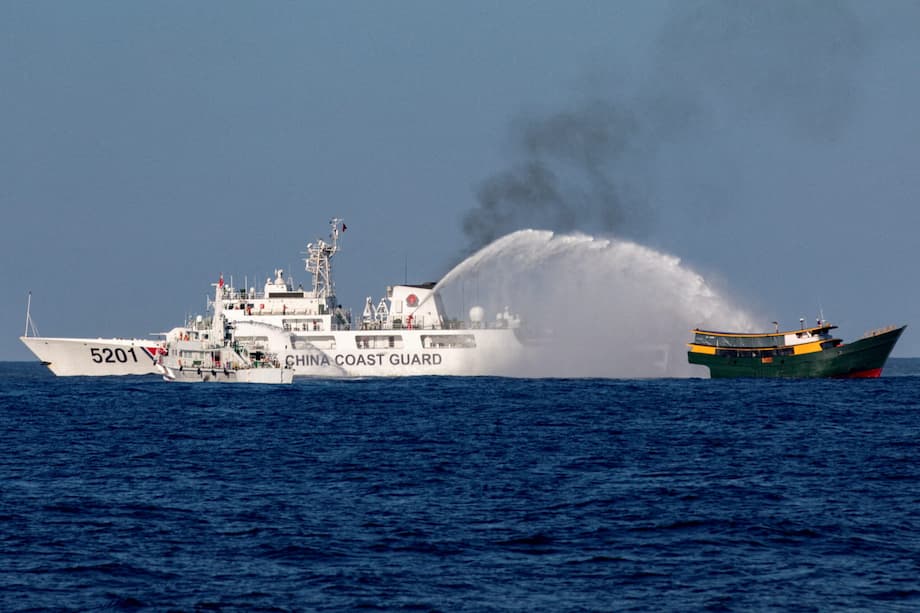A crisis that reaches from Palawan to Lombok
Across Southeast Asia, the seas that once fed coastal families and global markets are turning quiet. Off Rizal in Palawan, Filipino crews report being shadowed and chased by Chinese coastguard, navy, and militia vessels. Many fear that installations near Sabina Shoal will harden control of fishing grounds and shipping lanes. Far to the southwest at Tanjung Luar in East Lombok, the day begins with rows of sharks and rays pulled ashore, some from species considered threatened. In Thailand, migrant crews unload catch for cold storage while fishmeal factories grind small fish and bycatch into animal feed. The scenes are varied, but the storyline is shared. The catch is thinning, the work is harder, and the costs are rising.
- A crisis that reaches from Palawan to Lombok
- Flashpoints at sea in disputed waters
- From tuna capitals to empty holds
- Indonesia’s shrinking tuna and shifting seas
- Thailand’s seafood paradox
- Sharks, rays, and a food chain under strain
- Culture at risk from empty seas
- Why illegal and unreported fishing thrives
- What could turn the tide
- What to Know
Asian fisheries are the engine of global seafood. Over half of the world’s wild catch and aquaculture output comes from this region. Yet the pressure is intense. Illegal, unreported and unregulated fishing (IUU) now accounts for roughly one in five wild caught fish worldwide, generating up to 36.4 billion US dollars in illicit profits each year, with heavy concentration in Asian waters. Researchers estimate that 64 percent of Asian fisheries face medium to high risk, and that in the western central Pacific and the eastern Indian Ocean, IUU catch can exceed one third of recorded catch. Weak enforcement, corruption, and unresolved maritime disputes create fertile ground for IUU to flourish, according to analysis summarized by Earth.Org and other experts. See: Earth.Org overview of IUU in Asia.
The result reaches far beyond economics. Forced labor and trafficking have been documented on fishing vessels. Ghost nets tangle sea turtles, including the badly injured hawksbill seen under veterinary care in Rayong, Thailand. Shark markets expand while reefs degrade. Fishmeal demand drives harvest of small forage fish that other marine life need to survive. In photo essays from the Philippines, Indonesia, and Thailand, the human toll is visible in weary faces, while the ecological strain is measured in depleted stocks, damaged reefs, and growing dependence on imports in places that once relied on local catch.
Viewed together, these snapshots show a region at a crossroads. The crisis stretches from Palawan to Lombok and across the Gulf of Thailand; it touches market floors in General Santos, fish factories in Bitung, and ancestral waters of indigenous communities. It is a story about food, work, sovereignty, and the health of seas that bind this region together.
Flashpoints at sea in disputed waters
Fishing has become inseparable from geopolitics in the South China Sea. Filipino crews near Palawan describe run-ins with Chinese vessels, while analysts warn that new outposts can harden control over reefs and shoals that function as fish nurseries. Scientific work has documented extensive physical damage to coral reefs from large scale dredging and the harvesting of giant clams for building materials. One assessment found at least 160 square kilometers of coral reef damage in disputed zones, including 17 square kilometers of permanent loss from filling and harbor construction, and more than 140 square kilometers of longer term damage from dredging and clam extraction. See: ResearchGate summary of reef damage and cooperative solutions.
When reefs are dredged, fish lose critical habitat. That undercuts local food security and can push boats deeper into contested waters in search of a catch. Several marine scientists and policy experts have proposed cooperative approaches, including a peace park and joint resource management in the Spratly area, paired with a freeze on provocative construction. They argue that shared stewardship reduces tension and helps rebuild ecosystems that sustain fisheries and protect coasts.
From tuna capitals to empty holds
General Santos in the southern Philippines calls itself the tuna capital, and on many mornings the port lives up to the name. Traders scrutinize high grade fish that fly to Tokyo, Seoul, and Los Angeles. Nearby, industrial purse seine ships unload smaller juveniles that feed canneries. Local officials and campaigners acknowledge that juvenile catch is too common, and that monitoring gaps weaken rules meant to protect young fish. The global appetite for sushi and canned tuna has pushed fleets farther and kept boats at sea longer, while the fish grow smaller and scarcer.
One veteran fisherman described to reporters how the job has changed. He started by fishing near his home, returned with large fish after one night, and saw his earnings decline as trips grew longer and riskier. He spoke of months away from family and thin pay even after hard voyages.
It is harder now to make a living and feed my family.
A Greenpeace campaigner in the Philippines told The Guardian in 2018 that local fleets and industrial ships were removing too many juveniles, threatening the long term future of the stock.
They are taking out a generation of tuna.
The European Union once placed the Philippines on a warning list over fisheries governance, prompting a stricter law. Yet the port still reports juvenile fish on conveyors and unregulated activity offshore. Local regulators and traders say harvest limits, better on vessel monitoring, and traceability across the supply chain would help, along with labor protections that let crews seek help without fear.
Indonesia’s shrinking tuna and shifting seas
Indonesia is the second largest seafood producer after China, but its tuna sector is under stress from overfishing and a changing climate. Bitung, a major port city, has seen factory output and jobs fall as the catch declines. Workers leave canneries for other jobs. Fishers report longer trips and unpredictable weather patterns that complicate seasons their grandparents once read by wind and stars. These pressures cut into earnings and push crews into debt.
Ahmad Solihin, a former tuna cannery worker in Bitung, recounted his decision to quit the factory floor and drive a cab to support his family. He said the plant struggled to stay profitable as landings fell, overtime became essential to make ends meet, and even then his pay would not cover rent and basic needs. In an interview with Eco Business, he described the moment he left the industry.
As the fish catch declined, my employer could not gain profits and eventually I could not get an additional income. So I decided to leave.
Warjono, a fisherman from Pekalongan in Central Java, said weather is now so erratic that he cannot predict a good day at sea. What was once a ton of fish per trip fell by more than half in waters he knows well. In the same Eco Business report, he lamented how this uncertainty harms both safety and income.
If you cannot predict the weather and wind direction, just like our grandfathers did in the past, it means you cannot predict the catch.
Industry leaders confirm the squeeze. The Indonesian Longline Tuna Association reports that the number of tuna vessels in Benoa Bay dropped from around one thousand in 2009 to fewer than three hundred today as costs rose and fish grew scarce. Captains describe monthly hauls cut in half. In response, Jakarta has begun a Measured Fishing policy that will cap permitted catch in six zones and regulate seasons to allow recovery, while aiming to stabilize revenue and jobs. See: Eco Business on Indonesia’s tuna and climate pressures.
Thailand’s seafood paradox
Thailand is a regional seafood hub, but many Thai consumers now eat fish that arrives frozen from abroad because local stocks have declined. In Samut Sakhon, Burmese workers unload stingrays and other species for cold storage. Labor advocates have warned for years that weak oversight can hide trafficking, wage theft, and dangerous conditions. Several cases link IUU activity with forced labor. Part of the strain comes from a chain that starts with falling wild catch and ends with import dependence.
Further down the coast in Chumphon, fishmeal plants grind small wild fish and bycatch into feed for aquaculture and livestock. When forage species are removed at high volume, larger fish lose prey, and seabirds and marine mammals lose food. In Rayong, a hawksbill turtle recovered by Thai researchers lost both foreflippers after an encounter with discarded nets. These injuries show how ghost gear and waste amplify the harm from overfishing.
Sharks, rays, and a food chain under strain
At Tanjung Luar, one of Indonesia’s largest shark markets, fins go to Hong Kong and mainland China, while meat, skin, and cartilage enter local supply chains and cosmetics. Some landed species are endangered or vulnerable. Fishers and traders argue that shark fishing supports livelihoods where other options are scarce. Conservation scientists counter that current levels push species toward collapse and disrupt marine food webs.
Recent science strengthens those warnings. A global reassessment found that more than one third of shark and ray species face a high risk of extinction, with overfishing the universal driver of threat. The authors call for science based catch limits, effective marine protected areas, and trade controls that reduce mortality for the most threatened species. See: study on shark and ray extinction risk.
Culture at risk from empty seas
In Vietnam, the anchovies that give fish sauce its signature character are harder to find. Warming seas and falling oxygen levels push anchovy schools farther offshore or shrink them, while heavy fishing adds pressure. Producers in heritage towns say they struggle to secure the right fish at the right time, which weakens a craft passed down through families.
Bui Van Phu, who helps run a family business and teaches information technology, told NPR that he wants to pass the craft to his son, yet the sea now decides whether that is possible.
Fish sauce is not just a condiment but a craft, culture, and tradition that must be preserved.
Elsewhere, the Bajau Laut in Malaysia, a seaborne indigenous group, face a loss of identity as declining catch and unpredictable weather pull them from the ocean toward land based work. In parts of southern Thailand, the Urak Lawoi and other communities shift from fishing to tourism. These changes carry costs that cannot be measured only in income, because they break ties to place, skill, and belief that give meaning to daily life. See: NPR on Vietnam’s fish sauce pressures.
Why illegal and unreported fishing thrives
There is big money in rule breaking at sea. High global demand meets weak rules and low odds of getting caught. Transshipment at sea lets vessels offload catch to refrigerated carriers far from port, which hides where fish were caught and who caught them. Flags of convenience let owners register ships in distant countries with limited oversight. Crew lists change at sea. Bills of lading erase the origin of the fish. By the time the cargo reaches a port, the story of the catch is opaque. Analysts estimate IUU profits in the tens of billions of dollars each year, with heavy losses to coastal states that cannot collect license fees or taxes. See: Earth.Org on the economics of IUU.
The human costs are severe. Investigations have documented forced labor, debt bondage, and violent abuse on fishing vessels. Some crews are trapped for months or years without proper pay or documents. Filipino fishers around General Santos speak of being ordered to cross borders, getting detained abroad, and struggling to return home without help. When regulation is weak, abuses flourish and legitimate operators lose ground to those who cut costs by breaking the rules.
China, which has the world’s largest distant water fleet, is often at the center of regional friction. Chinese policy has begun to shift. New plans cap domestic marine catches, cut fuel subsidies, and pilot total allowable catch systems and vessel allocations. The government has stated it wants to shrink the offshore fleet and stabilize distant water output. Local protectionism and the pull of rising demand remain challenges, but reforms could reduce illegal activity if enforced consistently. See: East Asia Forum on China’s fishery policy shifts.
What could turn the tide
Rebuilding Southeast Asia’s fisheries is still possible. Global experience shows that stocks recover when governments set catch limits at sustainable levels, stop destructive gear, protect nursery habitats, and enforce the rules fairly. Aquaculture now supplies more than half of the world’s seafood, which can reduce pressure on wild stocks if farms use responsible feed and clean practices. Data from Our World in Data shows wild catch plateaued while aquaculture grew, proving that fish supply can rise without draining the ocean if management is sound. See: Our World in Data on global fish production and sustainability.
An ASEAN quota plan
Several policy thinkers argue that Southeast Asia needs a shared system to manage shared fish. One idea is an ASEAN led individual transferable quota program inside national exclusive economic zones. Governments would set annual catch limits by species, allocate shares to fishers, and allow trades of those shares. Quotas become assets that reward good stewardship and shift fishing to those who can operate efficiently. Evidence from other regions suggests that collapses are less likely where quota systems align public and private incentives, because fishers protect the long term value of their share.
Tools that work at sea and at port
- Set clear harvest strategies with annual catch limits based on best available science.
- Track vessels with tamper resistant monitoring and require electronic observers on higher risk ships.
- Control transshipment at sea by requiring prior authorization, monitoring, and full documentation, or move it into port.
- Join and enforce the Port State Measures Agreement to block illegally caught fish from entering markets.
- Adopt catch documentation and traceability that follow fish from net to plate.
- Ban destructive practices like blast and poison fishing and phase out the most damaging trawls in sensitive areas.
- Invest in alternative feeds for aquaculture to cut demand for fishmeal from wild forage fish.
- Protect coral reefs, seagrass, and mangroves which serve as nurseries for many commercial species.
- Support crew rights, union access, and grievance channels to tackle forced labor.
- Fund small boat safety, credit, and insurance so local fishers can comply with new rules and survive lean seasons.
Indonesia has experimented with tough enforcement in past years, and is now designing measured fishing zones that cap effort. China’s shift from fuel subsidies to stewardship incentives signals a change in priorities. The Philippines improved its legal framework after a European warning. These moves will matter only if satellite monitoring, port inspections, and court penalties close the loopholes that make cheating profitable. Buyers also play a role. Major brands can demand traceable supply, refuse transshipment without oversight, and favor gear and fisheries certified for lower bycatch and habitat impact.
What to Know
- Asian waters supply a large share of the world’s seafood, but 64 percent of regional fisheries face medium to high risk.
- IUU fishing likely accounts for about one in five wild caught fish globally and generates tens of billions of dollars in illicit profits.
- Filipino fishers near Palawan report harassment by Chinese vessels, while scientists document extensive reef damage in disputed areas.
- In General Santos, juvenile tuna landings and weak monitoring threaten the future of the fishery.
- Indonesia’s tuna sector has lost jobs and vessels as catch falls. A new policy will cap catch by zone to allow recovery.
- Thailand imports more seafood as local stocks decline. Fishmeal demand removes forage fish that other species depend on.
- More than one third of shark and ray species are threatened with extinction, driven mainly by overfishing.
- Vietnam’s fish sauce craft is at risk as anchovies decline and shift due to warming and deoxygenation.
- Forced labor and trafficking are linked to IUU operations, harming workers and undercutting legal fleets.
- Policy shifts in China, stronger regional cooperation through ASEAN, and tools like quotas, monitoring, and port controls can rebuild stocks if enforced well.




